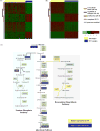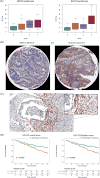GFPT2-Expressing Cancer-Associated Fibroblasts Mediate Metabolic Reprogramming in Human Lung Adenocarcinoma
- PMID: 29760045
- PMCID: PMC6030462
- DOI: 10.1158/0008-5472.CAN-17-2928
GFPT2-Expressing Cancer-Associated Fibroblasts Mediate Metabolic Reprogramming in Human Lung Adenocarcinoma
Abstract
Metabolic reprogramming of the tumor microenvironment is recognized as a cancer hallmark. To identify new molecular processes associated with tumor metabolism, we analyzed the transcriptome of bulk and flow-sorted human primary non-small cell lung cancer (NSCLC) together with 18FDG-PET scans, which provide a clinical measure of glucose uptake. Tumors with higher glucose uptake were functionally enriched for molecular processes associated with invasion in adenocarcinoma and cell growth in squamous cell carcinoma (SCC). Next, we identified genes correlated to glucose uptake that were predominately overexpressed in a single cell-type comprising the tumor microenvironment. For SCC, most of these genes were expressed by malignant cells, whereas in adenocarcinoma, they were predominately expressed by stromal cells, particularly cancer-associated fibroblasts (CAF). Among these adenocarcinoma genes correlated to glucose uptake, we focused on glutamine-fructose-6-phosphate transaminase 2 (GFPT2), which codes for the glutamine-fructose-6-phosphate aminotransferase 2 (GFAT2), a rate-limiting enzyme of the hexosamine biosynthesis pathway (HBP), which is responsible for glycosylation. GFPT2 was predictive of glucose uptake independent of GLUT1, the primary glucose transporter, and was prognostically significant at both gene and protein level. We confirmed that normal fibroblasts transformed to CAF-like cells, following TGFβ treatment, upregulated HBP genes, including GFPT2, with less change in genes driving glycolysis, pentose phosphate pathway, and TCA cycle. Our work provides new evidence of histology-specific tumor stromal properties associated with glucose uptake in NSCLC and identifies GFPT2 as a critical regulator of tumor metabolic reprogramming in adenocarcinoma.Significance: These findings implicate the hexosamine biosynthesis pathway as a potential new therapeutic target in lung adenocarcinoma. Cancer Res; 78(13); 3445-57. ©2018 AACR.
©2018 American Association for Cancer Research.
Conflict of interest statement
Competing interests: The authors declare no potential conflicts of interest.
Figures






References
-
- Warburg O. The metabolism of carcinoma cells. J Cancer Res. 1925;9(1):148–163.
-
- Hanahan D, Weinberg RA. Hallmarks of cancer: The next generation. Cell. 2011;144(5):646–674. - PubMed
-
- Zhang B, Zheng A, Hydbring P, Ambroise G, Ouchida AT, Goiny M, et al. PHGDH defines a metabolic subtype in lung adenocarcinomas with poor prognosis. Cell Reports. 2017;19(11):2289–2303. - PubMed
Publication types
MeSH terms
Substances
Grants and funding
LinkOut - more resources
Full Text Sources
Other Literature Sources
Medical
Research Materials
Miscellaneous

